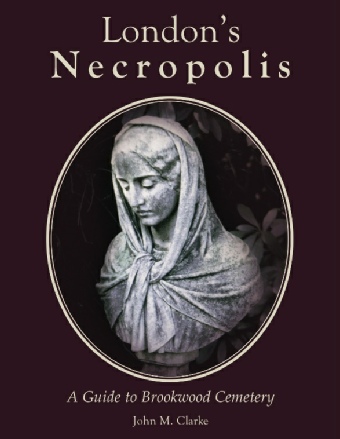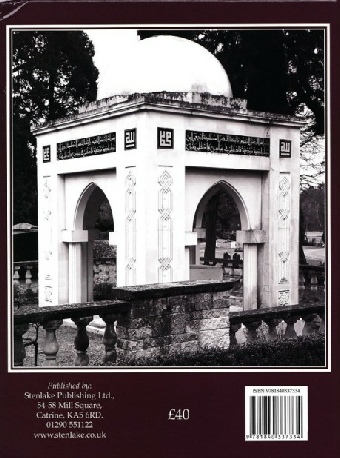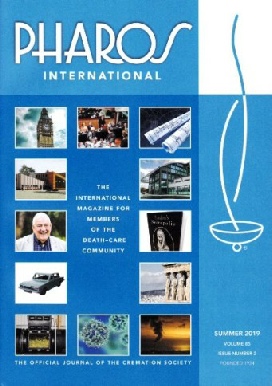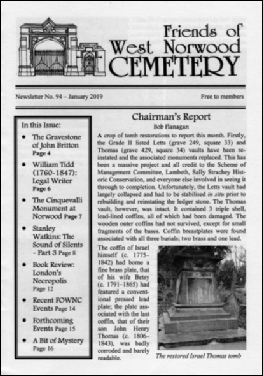

© John Clarke 2014-
John Clarke
Historian of Brookwood Cemetery

London’s Necropolis (2nd edition)

London’s Necropolis:
A Guide to Brookwood Cemetery
John M. Clarke
Published by Stenlake Publishing on 12 June 2018
Hardback, with 344 pages, and over 130 illustrations
Price: £40
ISBN-
You can order direct from here
(post free in the UK)
You can read some reviews here.
I am delighted to announce that having been out of print for many years, a new edition of my major guide to Brookwood Cemetery is now available.
 Originally published to celebrate the 150th anniversary of Brookwood Cemetery, London's Necropolis: A Guide to Brookwood Cemetery is the only major history and guide to Brookwood Cemetery.
Originally published to celebrate the 150th anniversary of Brookwood Cemetery, London's Necropolis: A Guide to Brookwood Cemetery is the only major history and guide to Brookwood Cemetery.
Brookwood was the largest burial ground in the world when it was opened in 1854 by the London Necropolis & National Mausoleum Company. Designed on a massive scale with avenues of sequoia, its own private railway and majestic planting, Brookwood is one of Surrey’s best-
The cemetery contains nearly 235,000 burials and although privately owned when the original edition appeared, it is now owned and managed by Woking Borough Council.
This is the long-
Nine chapters deal with specific areas or sections of the cemetery plus there are appendices on missing persons, the principal cemetery staff and burial statistics. The author brings the text to life with hundreds and hundreds of potted histories of the occupants. The editor of the book found himself going to Wikipedia to find out more about the colourful lives of those buried here. It may seem strange to observe that all human life is here, but as such a huge cemetery, containing thousands of the dead of a diverse metropolis, it has to be so.
London's Necropolis provides a history of the London Necropolis Company, a guide to the art and architecture of Brookwood Cemetery, and includes brief biographies of over 800 individuals of interest who have been buried there, reflecting all levels of a lost society.
Each chapter is supported by maps, and there are nearly 140 black and white photographs and line drawings to illustrate some of the most interesting memorials and cemetery structures. For the first time this edition identifies and describes all the mausoleums at Brookwood, including some that have been demolished.
Contents of the 2nd edition
Foreword by Julian W. S. Litten
Preface
Chapter 1: The London Necropolis Company and Brookwood Cemetery
Chapter 2: The Eastern Part of the Former Anglican Section
Chapter 3: St Cyprian’s Avenue
Chapter 4: St Chad’s and St George’s Avenues
Chapter 5: St Margaret’s Avenue and the ‘Ring’
Chapter 6: The ‘Gridiron’
Chapter 7: The Glades of Remembrance and the Cemetery Boundary
Chapter 8: The Eastern Part of the Former Nonconformist Section
Chapter 9: The Western Part of the Former Nonconformist Section
Chapter 10: The Military and Muslim Sections
Appendices
Notes
Bibliography
Index
* * * *
Some reviews of the second edition of London’s Necropolis
From Pharos International, Summer 2019, p.14.
“This book holds much appeal for scholars, professionals in the funeral industry and cemetery enthusiasts alike.”
 “This book documents the history of Brookwood Cemetery from its origins in the mid-
“This book documents the history of Brookwood Cemetery from its origins in the mid-
The opening chapter provides a detailed record of the cemetery and the London Necropolis Company who established it, with the subsequent chapters detailing a bewildering array of biographies of some of those interred at Brookwood in well researched detail, from anonymous pauper burials and those of criminals to the relics of saints and those associated with the monarchy. This book feels definitive in size and scope and is clearly a labour of love for its author who has extensively researched the cemetery and its records, as well as having conducted guided walks at the cemetery and been instrumental in setting up Brookwood Cemetery Society in 1992.
The book was originally published in 2004 to celebrate the 150th anniversary of the opening of Brookwood Cemetery -
Equally remarkable is that Brookwood Cemetery lists 235,000 individuals on its burial registers; both a testament to the size and original ambition for the cemetery when it was first established in 1854 by the London Necropolis & National Mausoleum Company, for it was intended to become London's only cemetery, large enough to serve the capital forever. Brookwood Cemetery provides a window onto Victorian and Edwardian ambition and an extensive socrio-
The enthusiasm and commitment he maintains for Brookwood Cemetery is in contrast to, as he notes in his Preface, our respect for such places until comparatively recently. He states that Victorian cemeteries have largely
been neglected because of a number of mid-
Equally important to note is the involvement that Brookwood Cemetery had in the early days of the Cremation Society in Britain who turned their attention to Woking to build their first crematorium, Meanwhile, a keen advocate of Brookwood Cemetery, the surgeon, Francis Seymour Haden, wrote to The Times on several occasions to publically denounce cremation and advocate ‘earth to earth' burial instead. For a brief period the London Necropolis Company held the patent rights for the ‘earth-
(Reviewed by Dr Hannah Rumble)
* * * *
From Newsletter 94, Friends of West Norwood Cemetery, January 2019, pp. 12-
“It is no exaggeration to say that our knowledge of Brookwood owes much to the efforts of John Clarke, who has researched and championed it ceaselessly for over 40 years.”
 “This book is the definitive guide to Brookwood, the largest burial ground in the world when opened by the London Necropolis & National Mausoleum Company in 1854. Designed with avenues of sequoia and its own internal railway connected to the London and South Western Railway line to Southampton, funeral trains ran regularly from the Company’s own station near Waterloo to stations within the cemetery until the 1940s. Now owned and managed by Woking Borough Council, the cemetery contains nearly 235,000 burials. In 1917 an area to the north of the cemetery was set aside for men and women of Commonwealth forces who died, many of battle wounds, in the London district. This site was further extended to accommodate Commonwealth casualties of the Second World War, and is now but one of several military cemeteries at Brookwood.
“This book is the definitive guide to Brookwood, the largest burial ground in the world when opened by the London Necropolis & National Mausoleum Company in 1854. Designed with avenues of sequoia and its own internal railway connected to the London and South Western Railway line to Southampton, funeral trains ran regularly from the Company’s own station near Waterloo to stations within the cemetery until the 1940s. Now owned and managed by Woking Borough Council, the cemetery contains nearly 235,000 burials. In 1917 an area to the north of the cemetery was set aside for men and women of Commonwealth forces who died, many of battle wounds, in the London district. This site was further extended to accommodate Commonwealth casualties of the Second World War, and is now but one of several military cemeteries at Brookwood.
It is no exaggeration to say that our knowledge of Brookwood owes much to the efforts of FoWNC Deputy-
“The contrast with Norwood is best summarized by the observation that private burials (burials in private graves) did not reach 10% of total burials at Brookwood until the early 1900s, and ‘pauper’ burials (burials paid for from public funds) remained at 75% of annual burials until this time. There are some Norwood connections, however. Although John has found no evidence to support the widely-
As to individuals, the novelist Dennis Yates Wheatley (1897-
One Brookwood burial that has always puzzled me is that of Allan Octavian Hume (1829-
(Bob Flanagan)
* * * *
From the Ancient Monuments Society Newsletter, Autumn 2018, p.56.
“Published originally to celebrate the 150th anniversary of the cemetery, it has now been reprinted in a brand new edition. Brookwood was the largest burial ground in the world when it was opened in 1854 by the London Necropolis and National Mausoleum Company. Designed on a massive scale with avenues of sequoia, it had its own private railway. It contains nearly 235,000 burials and, although privately owned when the original edition appeared, it is now in the hands of Woking Borough Council. There is a history of the company, a guide to the art and architecture of the cemetery and brief biographies of over 800 individual who are buried there. For the first time this edition identifies and describes all the mausolea at Brookwood including some that have been demolished.”